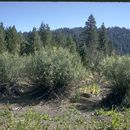zh-TW
在導航的名稱


Salix lemmonii (lat. Salix lemmonii) - söyüdkimilər fəsiləsinin söyüd cinsinə aid bitki növü.
Salix lemmonii (lat. Salix lemmonii) - söyüdkimilər fəsiləsinin söyüd cinsinə aid bitki növü.
Salix lemmonii is a species of willow known by the common name Lemmon's willow, named after J.G. Lemmon. It is native to western North America from British Columbia to California to Colorado, where it grows in moist and wet areas in mountain coniferous forest habitat, such as streambanks and meadows.
Salix lemmonii is a shrub growing 1 to 4 meters tall, sometimes forming colonial thickets. Its stems arise in a cluster and spread into many slender, angular branches. The leaves are up to 11 centimeters long, lance-shaped to oval with pointed tips, smooth or lightly serrated along the edges, and hairless and waxy or slightly hairy. The inflorescence is a stout catkin of flowers a few centimeters long, the female catkins lengthening to 6 or 7 centimeters as the fruits develop. This willow sometimes hybridizes with Salix geyeriana, to which it is closely related.[1]
This shrub is commonly used in revegetation projects in its native range, where it is useful for stabilizing eroded riparian habitat.[1]
Salix lemmonii is a species of willow known by the common name Lemmon's willow, named after J.G. Lemmon. It is native to western North America from British Columbia to California to Colorado, where it grows in moist and wet areas in mountain coniferous forest habitat, such as streambanks and meadows.
Salix lemmonii, es una especie de sauce perteneciente a la familia de las salicáceas. Es nativa del oeste de Norteamérica desde British Columbia a California y Colorado, donde crece en zonas húmedas y muy húmedas en las montañas en los bosques de coníferas en hábitat tales como arroyos y praderas.
Salix lemmonii es un arbusto que alcanza un tamaño de 1 a 4 metros de altura, a veces formando colonias en matorrales. Sus tallos se agrupan y se extienden en muchas ramas delgadas y angulares. Las hojas son de hasta 11 centímetros de largo, en forma de lanza, de forma ovalada con extremos puntiagudos, lisos o ligeramente dentadas en los bordes. La inflorescencia es un fuerte amento de unos pocos centímetros de largo, el amento femenino alcanza los 6 o 7 centímetros, cuando los frutos se desarrollan. Este sauce a veces se hibrida con Salix geyeriana, con el que está estrechamente relacionado.[1]
Este arbusto se utiliza comúnmente en la revegetación de proyectos en su área de distribución, en los que es útil para estabilizar la erosión ribereña del hábitat.[1]
Salix lemmonii fue descrita por Michael Schuck Bebb y publicado en Geological Survey of California 88, en el año 1879.[2]
Salix: nombre genérico latino para el sauce, sus ramas y madera.[3]
lemmonii: epíteto otorgado en honor del botánico John Gill Lemmon.
Salix lemmonii, es una especie de sauce perteneciente a la familia de las salicáceas. Es nativa del oeste de Norteamérica desde British Columbia a California y Colorado, donde crece en zonas húmedas y muy húmedas en las montañas en los bosques de coníferas en hábitat tales como arroyos y praderas.
Salix lemmonii est une espèce de saule connue aussi sous le nom de saule de Lemmon ((en) Lemmon's willow), portant le nom de John Gill Lemmon. L'arbuste est natif de l'ouest de l'Amérique du Nord jusqu'en Colombie britannique, Californie et Colorado, où il pousse dans les zones humides, parmi les forêts de conifères, sur les rives des cours d'eau et les prairies.
Salix lemmonii est un buisson de 1 à 4 mètres de haut, formant parfois de véritables fourrés. Ses feuilles font jusqu'à 11 centimètres de long, de lancéolées à ovales avec une extrémité pointue, lisses ou légèrement crantées sur les bords, glabres, parfois légèrement chevelues et cireuses. L'inflorescence se présente sous la forme de chatons. Le chaton femelle mesure de 6 à 7 centimètres de long, au moment de son développement extrême. Cette espèce s'hybride souvent avec Salix geyeriana, un proche « parent »[2].
On l'emploie souvent pour revégétaliser dans son aire d'origine où il est très utilisé pour stabiliser les berges érodées de son habitat[2].
Salix lemmonii est une espèce de saule connue aussi sous le nom de saule de Lemmon ((en) Lemmon's willow), portant le nom de John Gill Lemmon. L'arbuste est natif de l'ouest de l'Amérique du Nord jusqu'en Colombie britannique, Californie et Colorado, où il pousse dans les zones humides, parmi les forêts de conifères, sur les rives des cours d'eau et les prairies.
Salix lemmonii là một loài thực vật có hoa trong họ Liễu. Loài này được Bebb miêu tả khoa học đầu tiên năm 1879.[1]
Salix lemmonii là một loài thực vật có hoa trong họ Liễu. Loài này được Bebb miêu tả khoa học đầu tiên năm 1879.